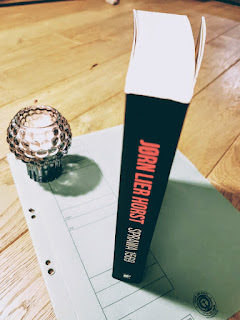Powieść o miłości
Ładnych już kilka miesięcy temu
znajomy podrzucił mi kilka książek, a wśród nich Stonera autorstwa Johna
Williamsa. Książka kompletnie nic mi nie mówiła, ale robiąc sobie chwilę
przerwy od biblioteki, sięgnęłam po tom piętrzący się na całym stosie pozycji
planowanych na później. Sięgnęłam i… przepadłam. Naprawdę rzadko zdarza mi się nie
móc się oderwać od książki, a to jeszcze w tygodniu roboczym, i przeczytać taką
pozycję w trzy dni. To mocny kandydat na książkę roku!
Współczesny Everyman
William Stoner jest doktorem na
uniwersytecie w Missouri, jednak jego historia nie jest oczywista. Pochodzi z
ubogiej farmerskiej rodziny, jego ojciec utrzymuje się z uprawy jałowego
spłachetka ziemi i – pragnąć poprawić los rodziny – wysyła syna na studia rolnicze
na rzeczony uniwersytet. Stoner rzetelnie się uczy, a mieszka u rodziny w zamian
za oporządzanie im gospodarstwa. Jednak w trakcie uczestniczenia w zajęciach
Archera Sloane’a z literatury angielskiej młody mężczyzna czuje, jakby otwierał
się przed nim zupełnie nowy świat, nieznana, fascynująca otchłań, a to
zauroczenie jest tak wielkie, że William porzuca swój kierunek na rzecz
literatury. Tak zaczyna się jego uniwersytecka kariera, która potrwa do końca
jego dni.
Nieszczęśliwe małżeństwo
Podczas jednego z akademickich
przyjęć Stoner poznaje Edith, córkę z zamożnego domu, w której się zakochuje.
Wysoka, smukła panna fascynuje młodego pracownika naukowego, a ona sama –
chociaż jej oczekiwania wobec życia i jego poziomu, zainteresowania, wychowanie
i wykształcenie różnią się od tego, co może jej zapewnić przyszły mąż – decyduje
się na małżeństwo. Jest to związek nieudany, nieszczęśliwy, którego owocem jest
córka Grace, którą Stoner początkowo wychowuje praktycznie sam. Edith
pozostanie dla mnie najbardziej zagadkową, smutną, mściwą postacią z książki,
której uda się wychować swoje jedyne dziecko na swoje podobieństwo.
Wygrane życie
Wydawać by się mogło, że Stoner
jest powieścią o przegranym życiu, o porażce i braku osiągnięć. William całe swoje
życie uczy studentów, a wyniku konfliktu z kolegą, a późniejszym rektorem, ma
na uczelni pod górkę. Jest autorem tylko jednej książki, a jego wykłady, przynajmniej
początkowo, nie przekazują jego ogromnej pasji do literatury. Ja jednak czytam
powieść Williamsa jako historię zwycięskiego życia. Po pierwsze, bohater wyrwał
się z ubogiej – również duchowo – egzystencji na wsi i podjął studia w dużym
ośrodku miejskim. Po drugie, kiedy doznał swojego literackiego olśnienia, nie wahał
się podążyć za swoją fascynacją i poświęcić jej życie, więc zajmował się czymś,
co darzył wielką miłością. Po trzecie, podczas konfliktu na uniwersytecie,
kiedy to Stoner oblał najpierw na swoim kursie, a potem podczas egzaminu
kalekiego i bezczelnego studenta Charlesa Walkera, wykładowca nie poszedł na
żadne kompromisy moralne, broniąc wstępu do kariery uniwersyteckiej manipulantom
nie mającym rzetelnej wiedzy. Zrobił to z pełną świadomością czekających go
konsekwencji, a więc reperkusji ze strony rektora, drobnych złośliwości,
utrudniania uniwersyteckiego życia. Po czwarte wreszcie, Stoner zaznał również
wielkiej miłości wdając się w romans z doktorantką Katherine Driscoll, z którą
oprócz żywego uczucia łączyła go również wspólna pasja do literatury, a para
była dla siebie wzajemnie inspiracją. Jednak wieści o ich romansie rozeszły się
również na uczelni, a mściwy rektor Lomax postanawia mścić się na słabszej stronie,
a więc na kobiecie. Katherine jest zmuszona porzucić uczelnię i wyjechać, a
Stoner zostaje, więc ich związek dobiega definitywnego końca i para już nigdy
się nie spotyka. Dane jest jednak bohaterowi kilka miesięcy niczym niemal
niezmąconego szczęścia, wspólnoty duchowej, jedności cielesnej wraz z
przekonaniem, że odnalazł miłość swojego życia. Czy zatem oprócz poświęcania
życia swojej pasji i zaznania pełnego szczęścia w relacji z drugim człowiekiem,
jest coś jeszcze, czego Stoner nie osiągnął?
A czego się spodziewałeś?
Na łożu śmierci Stoner rozważa
swoje życie i kilkukrotnie zadaje sobie pytanie: „A czego się spodziewałeś?”
Czy mógł bardziej starać się w związku z Edith? Bardziej zawalczyć o córkę,
zamiast biernie się wycofywać spod tyranii żony? Mocniej walczyć o swoje na
uniwersytecie, chcieć zajść wyżej w jego hierarchii? Czy to faktycznie miałoby
znaczenie? Wydaje się, że nie, a Stoner odchodzi spokojnie, z własną,
rozpoczynającą niezależne od niego istnienie, książką w ręku.
Powieść idealna
Mimo że sama fabuła nie niesie w
sobie żadnych sensacji, a William wiedzie żywot everymana, dotykają go
zwyczajne ludzkie problemy i zmartwienia, to od pierwszych linijek John
Williams rzuca na czytelnika niezwykły czar. Stoner jest napisany
językiem klarownym i jasnym, a jednocześnie tak pięknym i gładkim, że czułam
się, jakbym była niesiona przez fale, spokojnie, rytmicznie. Wielu krytyków
zwróciło uwagę na ten znakomity styl autora, zresztą biografia autora pióra
Charlesa J. Shieldsa nosi tytuł Mężczyzna, który napisał powieść idealną
(The Man Who Wrote the Perfect Novel: John Williams, Stoner, and the Writing
Life, 2018, nietłumaczona na język polski). Smutne, że mimo początkowych
dobrych recenzji w 1965 roku, kiedy książka się ukazała, rozeszło się mniej niż
2000 egzemplarzy i musiało minąć ponad 50 lat, by została w pełni doceniona już
po śmierci autora. W przypadku Williamsa sprawdza się więc powiedzenie Nie
wszystek umrę Horacego, a zachwyt czytelników to najlepszy pomnik. W moich
oczach lektura obowiązkowa.
Moja ocena: 10/10
John Williams,
Stoner Wydawnictwo Filtry, Warszawa 2023
Tłumaczenie: Maciej Stroiński
Liczba stron: 352
ISBN: 978-83-966748-2-1
********************************************************************************
A novel about love
A few months ago, a friend gave
me a few books, including Stoner by John Williams. As the title didn't
mean anything to me at all, the volume was waiting on top of a pile of books
planned for later. I reached out for it and… I was completely lost. It's really
rare for me to keep focused for such a long time and especially during the
working week, and read such a book in just three days. This is a strong
candidate for book of the year!
Modern Everyman
William Stoner is a doctor at the
University of Missouri, but his story is not obvious. He comes from a poor
farming family, his father earns a living by cultivating a barren piece of land
and - to improve the family's fate - he sends his son to study agriculture at
the university in question. Stoner studies diligently and lives with part of
his mother’s family in exchange for taking care of their farm. However, while
attending Archer Sloane's English literature classes, the young man feels as if
a completely new world opens up to him, an unknown, fascinating abyss, and this
infatuation is so great that William abandons his major in favor of literature.
This is the beginning of his university career, which will last until the end
of his days.
Unhappy marriage
During one of the university
receptions, Stoner meets Edith, a daughter from a wealthy home, with whom he
falls in love. The tall, slender woman fascinates the young scientist, and she
herself - although her expectations regarding life and its standard, interests,
upbringing and education are different from what her future husband can provide
her - decides to get married. It is an unsuccessful and unhappy relationship,
the result of which is a daughter, Grace, whom Stoner initially raises
practically alone. For me, Edith will remain the most mysterious, sad, vengeful
character in the book, who manages to raise her only child in her (unhappy) image.
Life won
It might seem that Stoner
is a novel about a lost life, about failure and lack of achievements. William
has been teaching students all his life, and as a result of the conflict with
his colleague, who later eas promoted to rector position, his University life
becomes hard for him. He is the author of only one book, and his lectures, at
least initially, do not convey his great passion for literature to his
listeners. However, I read Williams' novel as the story of a victorious life.
First of all, the hero escaped from a poor - also spiritually - existence in
the countryside and began studies in a large urban center. Secondly, when he
had his literary epiphany, he did not hesitate to follow his fascination and
devote his life to it, so he pursued something he had great love for. Thirdly,
during the conflict at the university, when Stoner failed the crippled and
impudent student Charles Walker twice, the lecturer did not make any moral
compromises, defending admission to a university career to manipulators who did
not have reliable knowledge. He did it with full awareness of the consequences
awaiting him, including repercussions from the rector, minor offenses, and
making university life more difficult. Fourthly, and finally, Stoner also
experienced great love by entering into an affair with doctoral student
Katherine Driscoll, with whom, apart from a keen affection, he also shared a
common passion for literature, and the couple was an inspiration to each other.
However, news of their affair also spread at the university, and the vengeful
rector Lomax decided to take revenge on the weaker party, i.e. the woman.
Katherine is forced to drop out of college and emigrate, and Stoner stays, so
their relationship comes to a final end and the couple never sees each other
again. However, the hero is given several months of almost undisturbed
happiness, spiritual community, bodily unity and the belief that he has found
the love of his life. So, apart from devoting your life to your passion and
experiencing complete happiness in a relationship with another person, is there
anything else that Stoner has not achieved?
What did you expect?
On his deathbed, Stoner reflects
on his life and asks himself several times: "What did you expect?"
Could he have tried harder with Edith? Fight more for his daughter instead of
passively withdrawing from his wife's tyranny? Fight harder for himself at the
university, go higher in its hierarchy? Would it actually matter? It seems not,
and Stoner passes away peacefully, with his own book in hand, which continies
its existence fully independent of its author.
The perfect novel
Even though the plot itself does
not contain any sensations, and William leads the life of an everyman and is
faced with ordinary human problems and worries, John Williams casts an
extraordinary spell on the reader from the very first lines. Stoner is
written in a clear and bright language, and at the same time so beautiful and
smooth that I felt as if I was being carried by the waves, calmly,
rhythmically. Many critics have noticed this excellent style of the author, and
the biography of the author by Charles J. Shields is titled The Man Who
Wrote the Perfect Novel: John Williams, Stoner, and the Writing Life, (2018,
untranslated Polish). It is sad that despite of initial good reviews, when the
book was published in 1965, less than 2,000 copies were sold and it took over
50 years for it to be fully appreciated, sadly after the author's death. In
Williams' case, Horace's saying "Not everything will die" applies,
and readers' admiration is the best monument. A must-read in my eyes.
My rating: 10/10
Author:
John Williams Title:
Stoner Publishing House: Filtry, Warsaw 2023
Translation: Maciej Stroiński
Number of pages: 352
ISBN: 978-83-966748-2-1































